Safe Use of Power Presses And Press Brakes
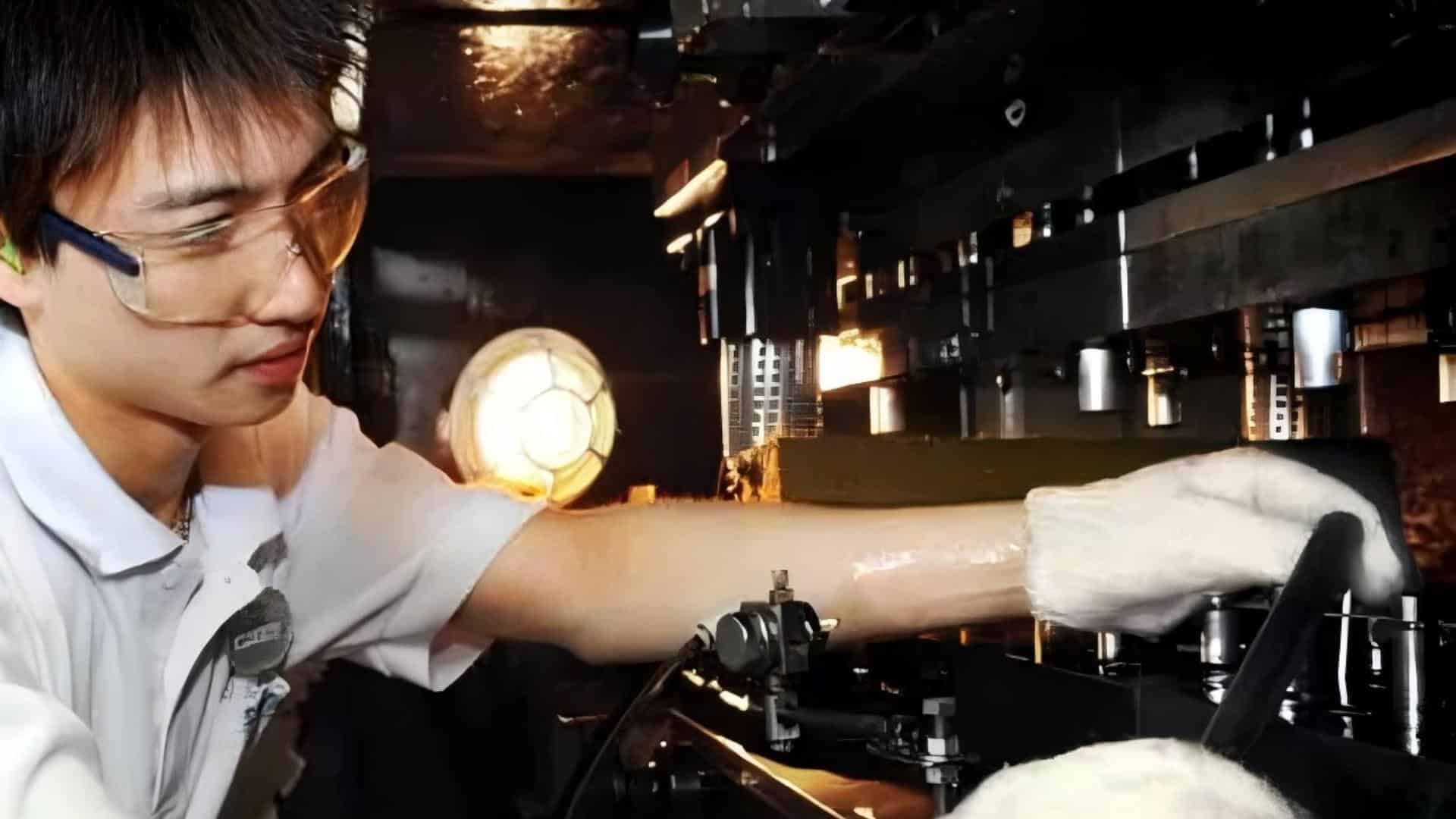
As a safety-conscious professional in the manufacturing industry, I understand the importance of the safe use of power presses and press brakes. These machines are essential tools in metalworking, but they also pose significant risks if not operated correctly. In this article, I will discuss best practices for ensuring safety while using power presses and press brakes, including proper training, equipment maintenance, and adherence to safety protocols. By prioritizing safety, we can create a more secure working environment and minimize the risk of accidents, ultimately enhancing productivity and worker well-being.
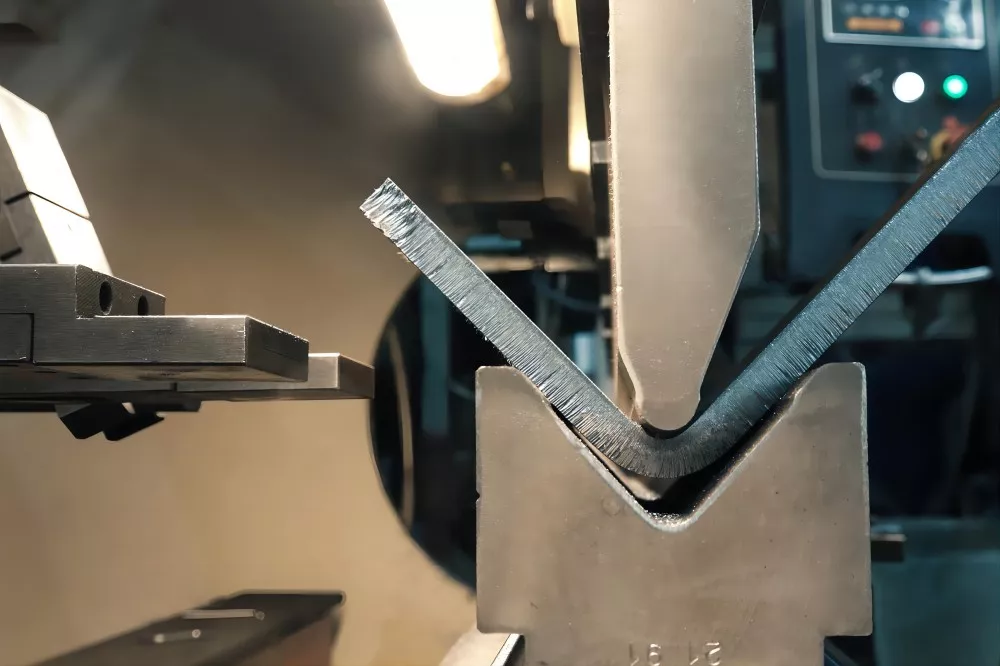
1. Introduction
This provides information on the usage of power presses and press brakes. It also highlights the hazards associated with the use of these machines, and provides methods for proper safeguarding during operation.
The objectives of this Technical Advisory are to:
• Incorporate safety and health requirements and measures during the installation,
commissioning, relocation, modification, setting up, operation and maintenance of power presses and press brakes;
• Inform on how to manage any risks that may arise from the use of these machines;
• Highlight the training requirements for personnel working with these machines.
Compliance with this Workplace Safety and Health does not, by itself, confer immunity from legal obligations.
2. Terms and Definitions
| Clutch(full revolution) | A type of clutch,when tripped or actuated,cannot be disengaged until the slide has completed a complete stroke. |
| Clutch (part revolution) | A type of clutch which can be engaged or disengaged atany point during the stroke of the slide. |
| Die | The tool used in a press for cutting or forming material |
| Safety block | The prop that prevents the ram from falling when inserted between the upper andlowerdies,or between the die bed and the face of theram. |
| Feeding | The process of placing or moving material into the point-of-operation. |
| Hazard | A source of possibleinjury or damage to health. |
| Lockout procedure | A set of action plans to ensure that all energysources to the relevant plant,machinery,equipmentorelectricalinstallation are isolated,disconnected or discharged;and to preventany part of the plant,machinery,equipment or electrical installation from being inadvertently initiatedor energised. |
| Risk | A combination of the probability and degree of possible injury or damage to health in a hazardoussituation. |
| Point-of-operation | The danger area on the material on which the dieis seton, positioned,and on which work is being performed onduring any process such as shearing,punching,forming or assembling. |
| Power press | A machine that shears,punches,forms or assembles metal or other materials bymeans of tools or dies attachedto slides |
| Press brake | A machine that generally limits to linear bending and formingof materials |
| Safe distance | The distance betweenaguard and thenearesthazard point the guard is intended to protect. |
| Shal | Indicates that a requirementis mandatory. |
| Should | Indicates a recommendation. |
| Single stroke | Each engagement of theclutch initiates the travel of the ram to complete one cycle or stroke. |
| Repeat stroke | Non-initiated power stroke occurring as a malfunction in the press mechanism. |
| Use | Any activity involvingmachinery,including starting,stopping, installing,commissioning,relocating,modifying,setting up, operating and maintaining. |
3. Power Press and Press Brake Hazards
There are many hazards when operating a power press and press brake and this chapter will focus on some of the obvious ones, in particular during the point-of-operation. The 12 main hazards to look out for are:
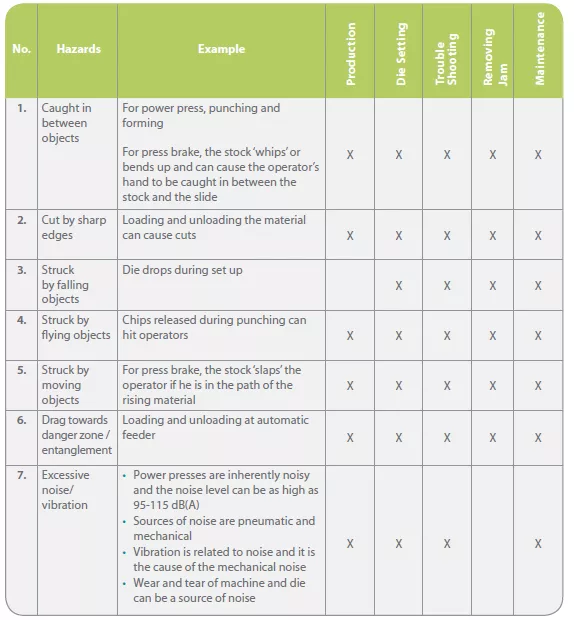
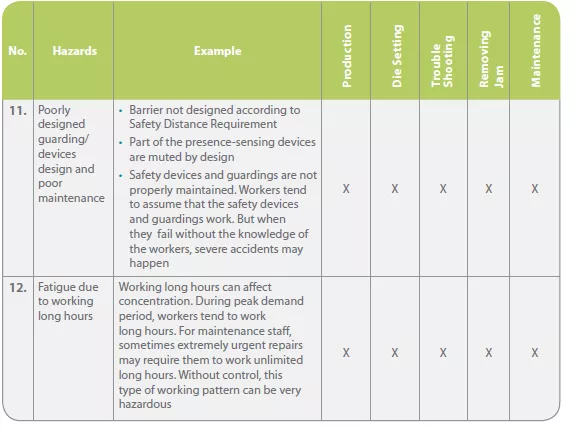
3.1 Being Caught in Between Objects
Power presses are used to punch, bend, or shear a metal work piece using a tooling or die attached to the slide and the bed (Figure 1). During a point-of-operation, severe crushing,amputation and even death may occur should “a caught in between” hazard occur.
Press brakes are used to bend metal sheets. While the actual operation of the press brake does not require the operator’s hands to be placed at the point-of-operation, the close proximity to the closing dies still poses a significant risk.

“Caught in between” hazards happen when the stock “whips”’ or bends up, creating a pinch-point hazard between it and the front face of the slide (Figure 2). Risk assessments must be performed when a new work activity or a change of work activity is introduced to the production and control measures must be taken accordingly.
The installation and removal of tooling provides the most direct exposure at the point-of-operation as the operator has to place his hands or even his head between the dies (Figure 3). The hand or head can be severely crushed if the ram were to fall during setup. The use of a safety block (Figure4) is necessary when performing this task.
3.2 Cut by Sharp Edges
Attention should be paid to the loading and unloading of materials and work pieces as the sharp edges of a sheet metal can cause cuts.
3.3 Struck by Falling Objects
Lifting of the die is needed during power press setup. During this time, due care must be taken to prevent the die from dropping. If the die drops, the operator risks severe injury and even death as the usual weight of a die is more than 500kg.
3.4 Struck by Flying Objects
During punching operations, metal chips from either material or die may break and fly out,especially if the power press is not aligned with the die. These flying metal chips can potentially hit the operator and other workers in the area and cause serious injury.
3.5 Struck by Moving Objects
This hazard can occur when operating a press brake. This happens when the sheet metal bends and its tip “slaps” the die-setter or troubleshooter during trial sample making (Figure 5).
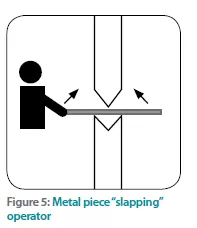
3.6 Dragged Towards Danger Zone
This is particularly hazardous for automatic feeding set-ups. Operators should take special care when using the machine (Figure 6).

3.7 Noise-induced Deafness
Power presses are inherently noisy and noise levels can be as high as 95~115dB(A). The sources of noise are likely to be pneumatic and mechanical vibrations. Machines with worn out parts also contribute to the high noise level. This can cause noise-induced deafness (NID).
3.8 Energy Source Failure
Electrical, mechanical and pneumatic machine components might fail. For example, the failure of a single-stroke linkage (mechanical), the failure of control relay (electrical) and the loss of air pressure (pneumatic) might pose hazards that are likely to cause accidents.
3.9 Unintended Energisation
Examples of unintended energisation include:
• The failure to properly disable, isolate energy sources or apply lockout procedures before a person performs servicing.
• Unprotected foot pedals that can introduce the possibility of accidental cycling. The risk occurs when the operator’s hands are inadvertently placed at the point-of-operation when the foot pedal is initiated.
• Bypassing controls of a single-operator press by having a co-worker initiate the controls while the operator positions or aligns parts in the die, or repairs or troubleshoots the press. This is an example of concurrent work which should be avoided.
3.10 Unsafe Work Behaviour
Unsafe behaviour is common in the workplace and can cause accidents. Some examples are:
• Guards and devices are bypassed;
• Two-hand controls are bridged to allow initiation with one hand;
• Two-hand controls are initiated with the help of co-workers;
• Failure to isolate or de-activate energy sources and to comply with lockout procedures before a person performs servicing and maintenance works.
3.11 Poor Design and Maintenance of Guards and Devices
Injuries and amputations are still prevalent even though safeguards and devices have been installed on power presses. While some accidents are due to unsafe behaviour, a number are due to poorly designed guards and devices.
For example, some presence-sensing devices are sometimes partially muted in their design and do not take the safety distance or gap into consideration.
Poor maintenance of guards and devices also contributes to accidents. Workers tend to assume that safety devices and guardings work. However, severe accidents do happen when they fail without the workers’ knowledge.
3.12 Fatigue Caused by Working Long Hours
During peak demand periods, workers work long hours. For maintenance staff, extreme and urgent repairs can require them to work long hours on end without rest. Moonlighting may also contribute to fatigue. Without proper control, such work patterns can result in fatigue-induced accidents in the power press environment.





















